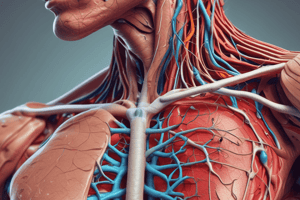Podcast
Questions and Answers
What role do veins play in the cardiovascular system?
What role do veins play in the cardiovascular system?
- They transport oxygen-rich blood from the lungs.
- They transport fluid back to the heart. (correct)
- They are involved in the production of red blood cells.
- They are responsible for the filtration of lymph.
Which of the following mechanisms aids in keeping blood moving towards the heart in the venous system?
Which of the following mechanisms aids in keeping blood moving towards the heart in the venous system?
- Absorption of blood in tissues.
- Increased blood pressure in capillaries.
- The pumping action of the stomach.
- The contraction of surrounding muscles. (correct)
What is a commonly recognized risk factor for venous stasis?
What is a commonly recognized risk factor for venous stasis?
- Low body weight.
- Frequent hydration.
- Regular exercise.
- Prolonged standing or sitting. (correct)
What is the primary function of the lymphatic system?
What is the primary function of the lymphatic system?
Which lymphatic duct drains the majority of the body?
Which lymphatic duct drains the majority of the body?
What is a characteristic of lymph nodes during local inflammation?
What is a characteristic of lymph nodes during local inflammation?
What physiological change occurs in pregnant women related to the vascular system?
What physiological change occurs in pregnant women related to the vascular system?
Which group of lymph nodes is considered accessible for inspection and palpation?
Which group of lymph nodes is considered accessible for inspection and palpation?
How do older adults' vascular systems often change?
How do older adults' vascular systems often change?
What is one of the major functions of lymph nodes?
What is one of the major functions of lymph nodes?
Flashcards are hidden until you start studying
Study Notes
Peripheral Vascular and Lymphatic Systems
- The vascular system comprises vessels that transport fluids like blood and lymph.
- Veins are known as capacitance vessels due to their ability to stretch and hold more blood when volume increases.
- Risk factors for venous stasis: standing, sitting, bed rest, hypercoagulation, vein wall trauma, varicose veins, obesity, pregnancy, and genetics.
- The lymphatic system is a separate system that retrieves fluid from tissues and returns it to the bloodstream.
- Right lymphatic duct: empties into the right subclavian vein.
- Thoracic duct: drains the rest of the body.
- Lymphatic system functions:
- Fluid return to the bloodstream
- Defense against infection
- Absorption of fat from the small intestine
- Lymph nodes:
- Small oval clumps of tissue located along lymphatic vessels
- Filter fluid before returning to the bloodstream
- Remove harmful organisms
- Pathogens are exposed to lymphocytes which trigger an antigen-specific response.
- Swelling and tenderness of nodes may indicate local inflammation.
- Accessible lymph node groups for inspection and palpation:
- Cervical
- Axillary
- Epitrochlear
- Inguinal
- Spleen, tonsils, and thymus: aid the lymphatic system.
Developmental Considerations
- Infants and Children: Lymph nodes are relatively large and superficial, making them easily palpable.
- Pregnant Women: Hormonal changes cause vasodilation and decreased blood pressure. This can lead to edema, varicosities, and hemorrhoids.
- Older Adults: Arteriosclerosis can cause rigid vessels, increasing the risk of peripheral artery disease.
Studying That Suits You
Use AI to generate personalized quizzes and flashcards to suit your learning preferences.




